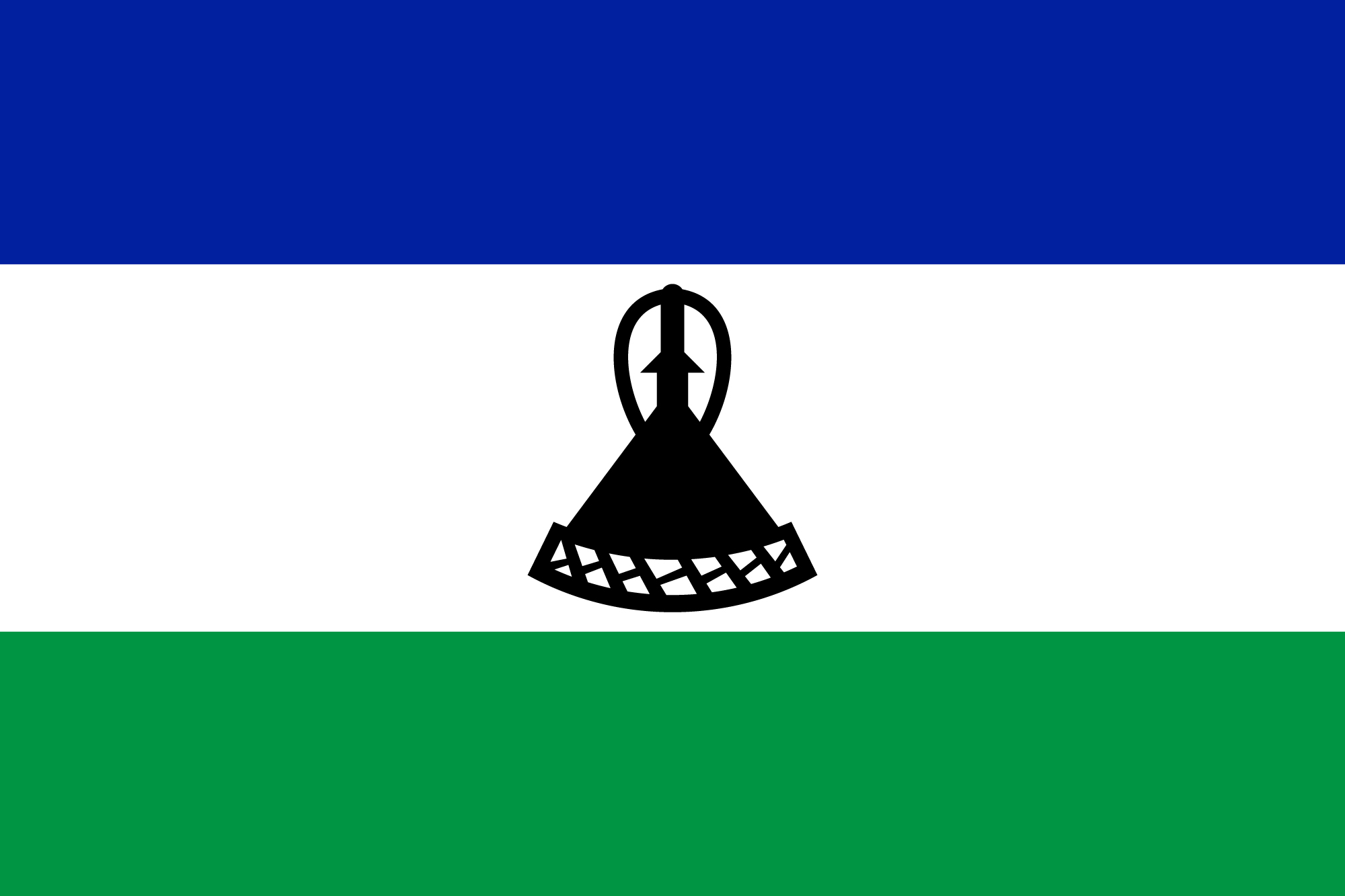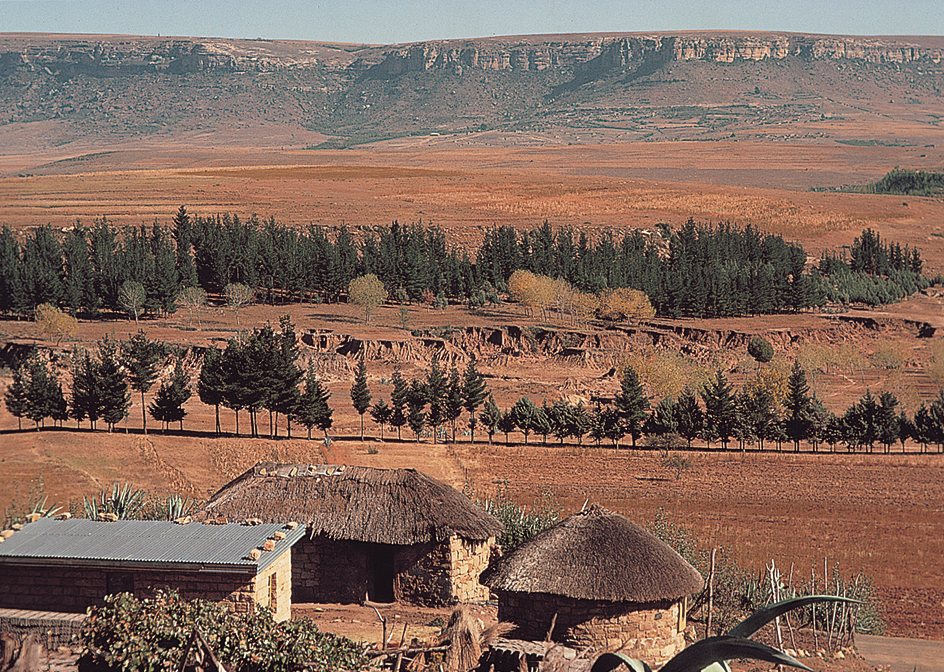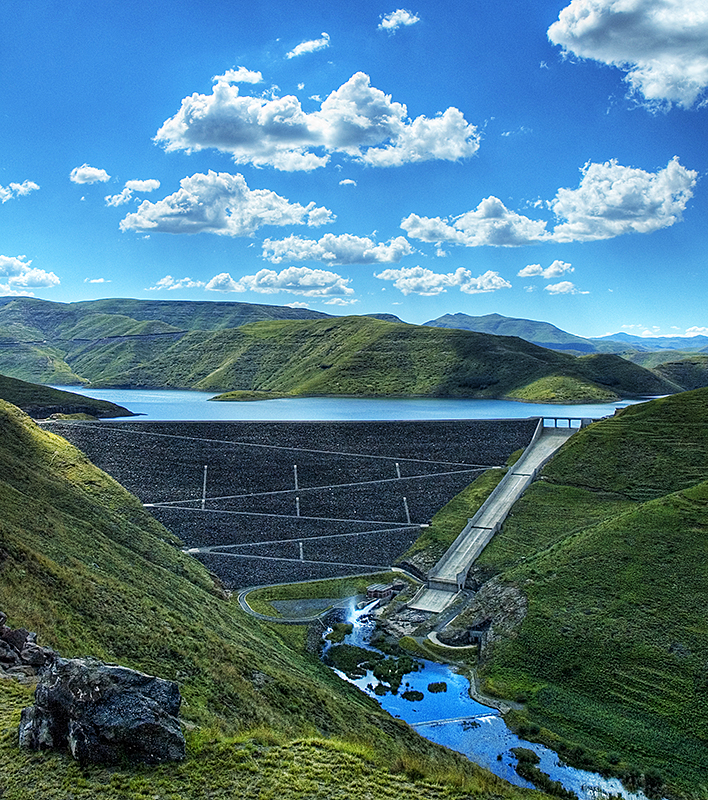Lesotho << lay SOO too or luh SOH toh >> is a rugged, mountainous country that is completely surrounded by the Republic of South Africa. It lies about 200 miles (320 kilometers) inland from the Indian Ocean. Lesotho is sometimes called the Switzerland of Southern Africa because of its beautiful mountain scenery. But it is a poor country. It has only a few manufacturing industries. Many of its people go to South Africa to find jobs.

Lesotho was formerly governed by the United Kingdom as the protectorate of Basutoland. It became independent in 1966. Maseru is its capital and largest town.
Government.
Lesotho is a constitutional monarchy. A king is the head of state. However, the king has no official power. A prime minister and a cabinet carry out the operations of the government. Lesotho’s parliament consists of a National Assembly and a Senate. The people elect the 120 members of the Assembly. The Senate consists of 22 local chiefs and 11 other members who are appointed by the king. The prime minister is the leader of the party that wins a majority of seats in the National Assembly. The prime minister appoints cabinet members. Lesotho is divided into 10 administrative districts for purposes of local government. Each district is headed by a district secretary.

People.
Most of Lesotho’s people belong to an ethnic group called the Basotho (also spelled Basuto). Many Basotho raise livestock and food crops. The wealth of a family is often measured by the number of cattle it owns. Most Basotho live in villages of fewer than 250 people. Family groups build their huts around a cattle kraal (pen) with open space separating each group. Traditional houses consist of mud or sod walls with thatched roofs. The Basotho often paint designs on the doors and walls. Wealthy Basotho live in stone houses with roofs of tin or tile. Each village has a khotla (meeting place) where men discuss village business.

The Basotho raise crops on the land surrounding the villages. All land is owned in common by the people, and local chiefs assign the land to the people.
The women do most of the heavy work on the farms and in the homes. They hoe and weed the land, harvest the crops, and build the houses. The men plow the land and look after the sheep, cattle, and goats. From the time they are 5 or 6 years old, boys herd livestock. On farms in the western plains, they return home with their herds every night. In the eastern highland areas, boys often spend months away from home, moving about with their flocks and herds in search of pasture.
Corn, sorghum, milk, and vegetables are the chief foods of the people. The women brew sorghum beer. In the 1800’s, the Basotho wore clothes that were made from animal skins. Most of them now wear Western-style clothing, but they often wrap themselves in blankets to keep warm.
English and Sesotho, a Bantu language, are the country’s two official languages. The traditional religions of the people are based on ancestor worship (see Ancestor worship). But most of Lesotho’s people now are Christians.
About 75 percent of the children in Lesotho attend elementary school, and most of the adults are able to read and write. About two-thirds of all schoolchildren are girls, because many boys spend their youth herding livestock. Missionaries run most of the schools. The National University of Lesotho is located in Roma.
Land.
Most of Lesotho is mountainous. The Drakensberg, a mountain range, rises to over 11,000 feet (3,400 meters) above sea level in the east. The Maloti (also spelled Maluti) Mountains, which are a part of the Drakensberg, cover much of central Lesotho. The only plains lie in the west. The Orange River rises in northeastern Lesotho.

Most of Lesotho has a mild, moist climate because most of the country lies more than 5,000 feet (1,500 meters) above sea level. The rainfall varies from year to year and place to place. Annual rainfall averages 28 inches (71 centimeters), and most of it falls between October and April. Temperatures in the western plains range from 90 °F (32 °C) in summer to 20 °F (–7 °C) in winter. In the highlands, snow falls and temperatures often fall below freezing in the winter.
Economy.
Lesotho is a poor country. It has a high unemployment rate, and many of its people live in poverty. Lesotho does not have enough jobs for its people. Many of Lesotho’s men work in South Africa in mines. The money that they send back to Lesotho is important to the country’s economy. Foreign aid is also important to Lesotho.
The country’s economy is dominated by subsistence agriculture. Subsistence farmers subsist, or survive, almost entirely on what they can grow or raise. Farmers raise beef and dairy cattle, goats, hogs, and sheep throughout the country. Farmers grow beans, corn, peas, potatoes, sorghum, and wheat. The best farming land lies in the western plains, where many of the people live. Overcultivation and overgrazing have damaged Lesotho’s soil.
Lesotho manufactures clothing, processed foods, and textiles. The country also mines diamonds.
Lesotho imports much more than it exports. Lesotho trades with other African countries, China, Hong Kong, Taiwan, and the United States. Lesotho imports agricultural products, machinery, manufactured goods, and medicines. Clothing is the country’s leading export by far. Lesotho also exports agricultural products and diamonds.
Most of the country’s roads lie in the western plains. Few roads are in the mountain areas. Lesotho has a short railroad connecting Maseru to South Africa. Maseru has an international airport.
History.
Ethnic wars swept over southern Africa in the late 1700’s and early 1800’s. Many ethnic groups were almost completely wiped out and their homes were destroyed. Some of the victims of this fighting fled into the highlands of what is now Lesotho. There they were given protection by an African chief named Moshoeshoe. He built a stronghold on a hill called Thaba Bosiu (Mountain of Night), about 15 miles (24 kilometers) from where Maseru now stands. By 1824, he had about 21,000 followers. He united them into the Basotho nation.
Later, British and Boer settlers tried unsuccessfully to defeat the Basotho (see Afrikaners). From 1856 to 1868, the Basotho were at war with Boer settlers. In 1868, Moshoeshoe asked the United Kingdom for protection. The United Kingdom established the protectorate of Basutoland. Moshoeshoe died in 1870, and in 1871 the territory was placed under the rule of the British Cape Colony, now part of South Africa. In 1884, Basutoland was reestablished as a British protectorate governed by a British colonial administrator. In 1910, the Basutoland Council was formed. Consisting of chiefs and elected members, it served as the national legislative council.
A constitution was drawn up in 1960 and revised in 1964. The first general election under this Constitution was held in 1965. The Basutoland National Party (BNP) won a majority of the seats in the new National Assembly, and Chief Leabua Jonathan, the BNP leader, became prime minister. Paramount Chief Motlotlehi Moshoeshoe II, great-grandson of Moshoeshoe, became king. In 1966, the protectorate of Basutoland became the independent kingdom of Lesotho.
During a general election in 1970, early vote returns showed that the BNP would not keep its majority in the National Assembly. Chief Jonathan then suspended the Constitution and elections. He continued to rule Lesotho as prime minister. In 1986, military leaders overthrew Chief Jonathan and took control. In 1990, the government forced King Moshoeshoe II to leave office and installed his oldest son as King Letsie III.
In 1993, Lesotho returned to a civilian government. In a multiparty election, the Basotho Congress Party (BCP) won all the seats in the National Assembly. In 1995, Letsie III gave up the throne, and his father was reinstated as King Moshoeshoe II. Moshoeshoe II died in 1996, and his oldest son returned to the throne as King Letsie III.
In 1997, a large faction of the BCP broke away and formed a new party, called the Lesotho Congress for Democracy (LCD). In elections held in May 1998, the ruling LCD won almost all the seats in the Assembly. Opposition parties claimed that the elections were fixed, and protests broke out against the government. In September 1998, South Africa and Botswana sent troops to Lesotho in support of the government. After much bloody fighting, an agreement was reached between the government and the opposition, calling for new elections. In the elections, held in 2002, the LCD kept control of the Assembly. The LCD remained in control of the Assembly after elections in 2007.
Following elections in 2012, the All Basotho Convention (ABC) party formed a coalition (partnership) government with the LCD. Thomas Thabane, head of the ABC, became prime minister. After Assembly elections in 2015, the Democratic Congress (DC) party formed a coalition government with the LCD and other parties. Elections were held yet again in 2017. The ABC received more votes than any other party, but it lacked a majority. The ABC formed a coalition government with three smaller parties, and Thabane returned as prime minister. In 2020, Thabane was accused of involvement in the murder of his former wife, Lipolelo Thabane, in 2017. He denied the charges, and resisted pressure from his party to resign. However, after his coalition government collapsed in May 2020, Thabane resigned. The party chose Finance Minister Moeketsi Majoro to succeed him as prime minister. In 2022, the charges against Thabane were dropped.
See also Drakensberg; Maseru; Moshoeshoe; Orange River; Sotho.
